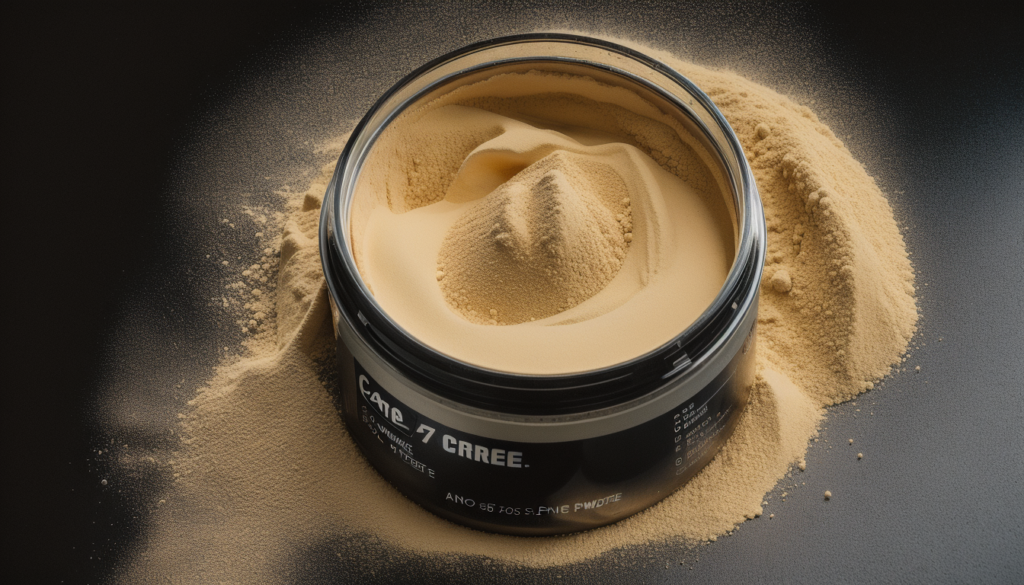Introduction
We have all been there. You just finished washing out your blender bottle after having your protein shake, you have already stashed it away in your gym bag in preparation for tomorrows lift, and then you just realized that you forgot to take your beloved creatine! You reach for the container only to down the recommended dosage straight into your mouth and then swish it around with water to mix it up, just like the good gym bro that you are. But is this ok? Can you dry scoop creatine? Before we dig into this, let’s first understand how creatine powder works.
How Does Creatine Powder Work?
Creatine powder is a popular supplement among fitness enthusiasts and athletes due to its potential performance-enhancing benefits. Understanding how creatine powder works is essential for maximizing its effectiveness and safety.
Creatine is a naturally occurring compound found in small amounts in foods like meat and fish. It plays a crucial role in the production of adenosine triphosphate (ATP), which is the primary source of energy for muscle contractions. When you engage in high-intensity activities like weightlifting or sprinting, your muscles require a rapid supply of ATP to sustain their performance.
By supplementing with creatine powder, you can increase your body’s creatine stores, leading to higher levels of ATP production. This allows your muscles to work harder and longer before experiencing fatigue, ultimately leading to increased strength, power, and muscle mass.
When consumed orally, creatine powder is rapidly absorbed into the bloodstream and transported to the muscles. Once inside the muscles, creatine combines with phosphate molecules to form phosphocreatine. During high-intensity exercise, phosphocreatine donates its phosphate group to ADP (adenosine diphosphate), converting it back into ATP. This replenishment of ATP allows for sustained muscle contractions and improved exercise performance.
To achieve the desired benefits, it is important to follow the recommended dosage guidelines for creatine powder. Typically, a loading phase is recommended for the first week, where higher doses are taken to saturate the muscles with creatine. This is followed by a maintenance phase where lower doses are taken to maintain the elevated creatine levels in the muscles.
Is it Safe to Dry Scoop Creatine?
Risks of Consuming Dry Powder
Creatine powder is very fine and can be difficult to swallow without mixing it with a liquid. It may stick to the roof of your mouth or throat, causing discomfort or even choking. Additionally, consuming creatine powder without diluting it may lead to stomach discomfort or digestive issues. For these reasons alone, we know it is not safe to dry scoop pre-workout.
Effects on Absorption
Mixing creatine powder with water or another beverage not only makes it easier to consume but also helps with its absorption. When mixed with a liquid, creatine powder forms a solution that is quickly and efficiently absorbed by the body. This allows for better distribution of creatine to the muscles, maximizing its performance-enhancing effects. Dry scooping on the other-hand limits our absorption rate, making it less desirable.
Effects on Taste
Mixing creatine powder with water or a beverage can help mask its taste. Creatine powder has a slightly bitter taste that some people find unpleasant. By mixing it with a flavored liquid, you can make it more palatable and enjoyable to consume.
Risks of Tooth Decay
Creatine powder is acidic in nature, and when consumed on its own, it can lead to an increase in tooth enamel erosion and tooth decay. This is especially true if the powder is left in direct contact with the teeth for an extended period of time.
By diluting creatine powder in a liquid, you can reduce its acidity and minimize the risk of tooth decay. Additionally, drinking water or rinsing your mouth after consuming creatine powder can help remove any residue and protect your teeth.
How to Use Creatine Safely
To use creatine safely, it is important to follow the recommended dosage guidelines and mix it with a liquid before consuming. Here are some steps to help you use creatine safely:
Start with a Loading Phase: During the first week of taking creatine, it is recommended to go through a loading phase. This involves taking higher doses to saturate the muscles with creatine. The typical loading dose is 20 grams per day, divided into four doses of 5 grams each.
Transition to a Maintenance Phase: After the loading phase, you can transition to a maintenance phase where lower doses are taken to maintain the elevated creatine levels in the muscles. The typical maintenance dose is 3-5 grams per day.
Mix Creatine with Water or Another Beverage: Mix the recommended dose of creatine powder with water or another liquid of your choice. This will make it easier to consume and help with its absorption.
Drink it immediately: Once you have mixed the creatine powder with a liquid, drink it immediately. This will ensure that the creatine is quickly absorbed by the body and can be efficiently delivered to the muscles.
Stay hydrated: Creatine can increase water retention in the muscles, so it is important to stay hydrated while taking it. Drink plenty of water throughout the day to support the effectiveness of creatine and prevent dehydration.
Consult with a healthcare professional: Before starting any new supplement regimen, it is always a good idea to consult with a healthcare professional, especially if you have any pre-existing medical medications.
Myths Surrounding Creatine Usage
Creatine is a popular supplement among fitness enthusiasts, but there are also many myths and misconceptions surrounding its usage. It is important to separate fact from fiction to use creatine safely and effectively. Here are some common myths surrounding creatine usage:
“Creatine is a steroid”: This is a common misconception, but creatine is not a steroid. It is a naturally occurring compound found in our muscles and can also be obtained from dietary sources such as meat and fish. Powdered creatine supplements simply provide an additional source of this compound to enhance athletic performance.
“Creatine is only for bodybuilders”: While creatine is commonly associated with bodybuilding, it can benefit individuals engaged in various forms of exercise, including endurance athletes and team sport players. Creatine helps to improve strength, power, and overall exercise performance.
“Creatine causes kidney damage”: There is no scientific evidence to support the claim that creatine causes kidney damage in healthy individuals. Studies have shown that when taken within the recommended dosage guidelines, creatine is safe and does not put a strain on the kidneys. However, it is important to consult with a healthcare professional if you have any pre-existing kidney conditions.
“Creatine leads to dehydration”: Creatine does not directly cause dehydration. In fact, it can increase water retention in the muscles, which can be beneficial for performance. However, it is important to stay hydrated by drinking plenty of water while taking creatine to prevent any potential dehydration.
Conclusion
In conclusion, it is not recommended to dry scoop creatine. When used properly creatine is a safe and effective supplement. It can enhance athletic performance for individuals engaged in various forms of exercise. Remember to consult with a healthcare professional before starting any new supplement regimen, stay within the recommended dosage guidelines, and stay hydrated throughout the day. With proper usage, creatine can be a valuable tool in strengthening your body.
Did you like this article? Get in contact with us! Let us know what kind of content you would want to see!



Pingback: Can You Take Creatine Before Bed? A Comprehensive Guide